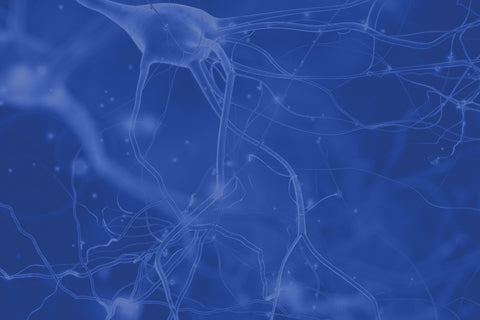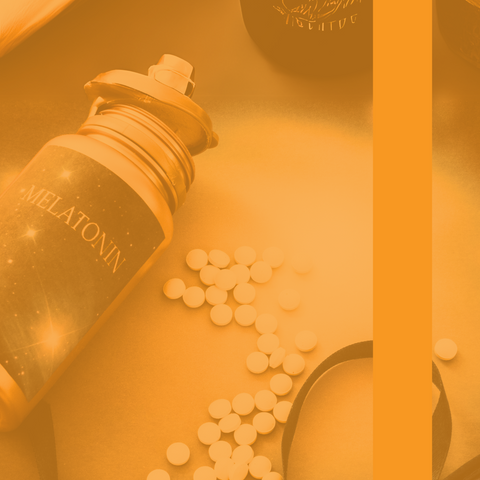
Originally, this article was featured on Dave Asprey’s Biohacked blog but in an abbreviated and less interesting form. Read on for more information, more vulgarity, and more blue.
If you could upgrade your brain and protect it at the same time, would it be worth peeing blue?
How about if this same compound, depending on the dose, was an antimicrobial (possibly even against those pesky coronaviruses), an antidepressant, and a potential treatment for both neurodegenerative diseases (Alzheimer’s, Parkinson’s, etc.) and cancer?
If so, read on and get ready to #blueyourself because today we are taking a deep dive into the history, science, and massive potential of methylene blue (MB).
Methylene Blue's History
MB has a very colorful (blue? 😁) history. It was initially developed in the late 1800s as a dye for use in textile manufacturing (fun fact: it was the dye initially used to make jeans blue), but soon after it was synthesized, several medical applications were discovered, the first of which was for the treatment of malaria. MB was also used effectively as an antifungal, antiviral, and antibacterial agent before prescription antimicrobials became available in the 1950s. It is still used as an antifungal agent in fish tank cleaners. More on this later but if you are going to try MB, please don’t drink fish tank cleaner and potentially win a Darwin Award!
In the mid-20th century, MB was discovered to have antipsychotic and mood enhancing properties. It was also added to other drugs to ensure medication compliance. Blue urine? You’ve been taking your drugs!
Beginning early in the 20th century, MB was regularly used as a bacteriologic stain, a cellular stain, an indicator dye, and for surgical and medical marking. Its use continues to the present day.
Recently, there has been significant interest in MB because of several studies showing that it may improve learning, memory, and be neuroprotective (see below). It is also re-emerging as a possible treatment of malaria because of drug resistant strains and as a way to fight other infections as well, especially when combined with certain spectrums of light.
Methylene Blue's Cellular Mechanisms: 8 Reasons Why Low-Dose Methylene Blue is a Biohacker’s Delight
MB is an electron cycler, both donating and accepting electrons. After absorption in the buccal mucosa (e.g., in a troche), oral ingestion, or IV administration, MB concentrates in tissues with the most mitochondria (e.g., the brain where it readily crosses the blood brain barrier, the heart, the liver, and kidneys).
It is at low doses that MB makes (blue) magic happen. Here are the 8 most promising ways it works:
- MB donates electrons to the electron transport chain (ETC) and increases ATP production. This effect can occur in the presence or absence of oxygen. Forgot how the ETC works? Watch this video (start at 1 minute).
- MB enhances the function of cytochrome oxidase (complex IV), making it work faster and more efficiently. This leads to increased oxygen consumption and increased ATP production, especially in the most metabolically active cells like the nerve cells in memory regions of the brain!
- MB stimulates glucose metabolism in conditions without oxygen and increases the amount of NAD + produced by mitochondria. The greater the amount of NAD+, the younger your cells remain/become due to sirtuin activation (see David Sinclair’s book Lifespan for more information).
- In red blood cells, low dose MB changes the configuration of the iron (heme) in hemoglobin, the molecule in a red blood cell that carries oxygen. This improves the oxygen-carrying capacity of hemoglobin which leads to increased ATP production from the ETC.
- Low dose MB also functions as a powerful antioxidant as it scavenges the mitochondria and cytosol for free electrons to accept and neutralize. On the macro level, this is how MB may be neuroprotective and even reverse skin damage (see below).
- Low dose MB also has antidepressant effects, functioning as a monoamine oxidase (MAO) inhibitor. Inhibiting MAO prevents monoamine neurotransmitter breakdown (dopamine, melatonin, and serotonin) which leads directly to increases in these neurotransmitters.
- Low dose MB may also function as a cholinesterase inhibitor, increasing the amount of acetylcholine available, a neurotransmitter in the brain responsible for arousal, attention, memory, and motivation.
- Low dose MB combined with certain spectrums of light (UV, primarily) may also be anti-infective against viruses.
Amazingly, there are 4 distinct ways MB increases cellular energy (ATP) production, three of which are related to its direct effects on the mitochondria. Are you paying attention yet?
Moderate to High Doses of Methylene Blue
At moderate doses (4 to 10 mg/kg in most studies), MB becomes a pro-oxidant and facilitates the generation of singlet oxygen and peroxide radicals, especially in the presence of certain spectrums of light. This is likely the way MB works against septic shock (via nitric oxide synthase inhibition) and possibly in cancer treatment synergy.
At high doses (>10 mg/kg), MB can have harmful oxidative effects.
Are You Blue with Envy yet? Methylene Blue Research and Potential Indications
The only FDA-approved treatment of MB is for a condition called methemoglobinemia where MB helps oxygen bind to hemoglobin. If hyperbaric oxygen therapy isn’t available, or if there are delayed symptoms, MB is also used for carbon monoxide poisoning secondary to its antioxidant and energy enhancing effects in the mitochondria.
Outside of the FDA, MB has been shown in several non-human studies to be neuroprotective and improve many aspects of learning and memory. There is a wealth of animal data showing the impressive learning upgrades possible with MB.
In a recent human study, a single low dose of oral MB was shown to increase functional magnetic resonance imaging activity during sustained attention and short-term memory tasks. It also improved memory retrieval. In short, it made study participants more focused and smarter. Kind of awesome, huh?
More human trials are underway... and many n=1 studies too. :)
One of the most promising areas of MB research is in neurodegenerative disease. Recent studies in animal models of Alzheimer's Disease have shown that MB may slow the formation of amyloid plaques and neurofibrillary tangles. A pharmaceutical drug derived from MB has also shown benefits in both Alzheimer’s disease and frontotemporal dementia (Lewy Body Disease) and is currently in late-phase trials.
There have also been several studies recently on the combination of MB and UV light killing various viruses. In addition, there is ongoing research in MB for brain injury, cancer, malaria, hepatitis C, various skin conditions like psoriasis, and many more.
Methylene Blue Safety
MB is a very safe drug, especially when taken at low doses and when purity/potency tested. The most common (and harmless… and awesome?) side effect of MB is blue urine. Because of the potential risk of serotonin syndrome (a life-threatening condition), do not combine MB with SSRIs, SNRIs, or drugs that increase serotonin levels except under the very close supervision of a provider. For all you psychonauts out there considering MB, certain psychedelic substances like MDMA and psilocybin increase serotonin and the vine in ayahuasca ceremonies has MAOI properties like MB... so be mindful of what you are stacking/ingesting and wait at least 24 hours before having MB and these compounds.
Are you pregnant or breastfeeding? Please don’t take MB. It is contraindicated (e.g., it ain't good for the babies on board).
At high doses (>10 mg/kg), MB may cause a litany of potential side effects including hypertension, methemoglobinemia (a condition it actually treats at low doses), dizziness, gastrointestinal distress, affect readings of a pulse oximeter, induce hemolytic anemia in patients with a genetic condition called G6PD, and more.
Don't Drink Fish Tank Cleaner, Please! Go Beyond USP!
Whatever you do... please do NOT drink fish tank cleaner. Although it has MB in it to treat fish fungal infections, fish tank MB is not only diluted with water to around 2% purity, it also contains a lot of impurities and heavy metals such as arsenic, aluminum, cadmium, and lead. Industrial- and chemical-grade MB can also consist of up to 11% of impurities as well.
Your safest choice is USP (pharmaceutical grade) MB, but even that can have impurities. This is why it’s important not only to ensure your MB is USP but that it also has testing that documents its purity and potency.
However, even USP-grade MB can contain the aforementioned impurities. This is why it’s important that the MB you are consuming comes with documentation of purity and potency along with a USP designation (Hint: This is what we do at Troscriptions + one more vital step!).
At Troscriptions our MB is third-party tested by our manufacturer to ensure purity/potency, USP grade, AND independently tested AGAIN for purity/potency with each troche batch we make. This is why we call it Beyond USP MB. There are very few, if any other companies out there, with as rigorous a process as ours to ensure the highest quality possible.
Troscriptions to the Rescue
Troscriptions (Tx), founded and pioneered by Dr. Ted Achacoso, has two nootropic troches (Blue Cannatine and Just Blue) that are made with Beyond USP MB.

Blue Cannatine is formulated with 5 mg of MB + nicotine, caffeine, and hemp extract for a wide focus that launches your brain into git-er-done “limitless mode." All ingredients in this formula (and in all Troscriptions products) are precision dosed, physician formulated, and purity/potency tested.
At the request of biohackers like you, Just Blue was developed. It is a 16 mg pure MB troche made with USP potency/purity tested MB. Dr. Ted likes to say that Just Blue functions as a brain health optimization supplement. It “powers you up like a gentle wind that lifts the glider wings of your brain for long and BRIGHT focus." Translation: Your brain is ON and it’s a smooth blue ride.






Comments (11)
Hi there! Thanks so much for the comments. Here are some answers
1) Nicotine at very high doses can be a poison but at 1mg/troche in our Blue Cannatine, it is very safe when used as directed.
2) When you stop taking MB, if your system is now better optimized, the effects should be long lasting. If If it’s not, effects may wane.
3) Yes at low doses, MB is safe for the eyes
4) MB may stain dental fillings but unlikely to do so. You’ll need to discuss with your dentist for if you are concerned, you can swallow the troche (just do it on an empty stomach)
5) Yes you can combine MB with Redlight for synergistic effect!
6) Yes you can take B12 and ashwaganda w/MB but we always suggest doing your own research and speaking to your healthcare provider
More of a question-Is nicotine in small doses NOT a poison?
What happens when you stop taking MB? Are the affects long lasting or do you revert back to your unwell self?
Thank you 🙏🏻
Is MB safe for the eyes? I have a connective tissue disorder, Ehlers Danlos Syndrome, so must be very careful to investigate products before use. I once used Provigil and had a posterior vitreous rupture, which I know stemmed from using that stimulant drug.
Will methylene blue stain, dental fillings? If so, for how long?
Is MB oral dosing and UV effective/combo ie using with the sun/exposure and or utilizing with red light therapy ?
Can you take B 12 supplement with MB
Can I take Ashwagandha while taking MB?
Hi Grant!
Yes, you can use MB w/HBOT but there are no current studies on this combination. We believe that MB will increase energy production + antioxidant potential but the exact dosing isn’t clear just yet. We’d start low and go slow!
What are the benefits and risks, if any, to taking MB prior to Hyperbaric Oxygen Therapy (HBOT)? Have there been any clinical trials on this? If it is safe and effective prior to HBOT, what dosage would be appropriate?